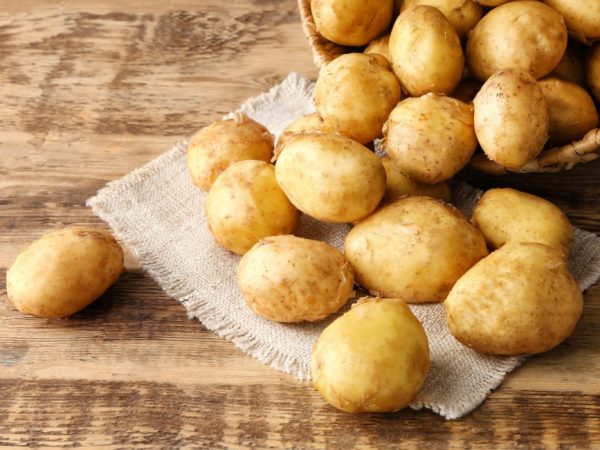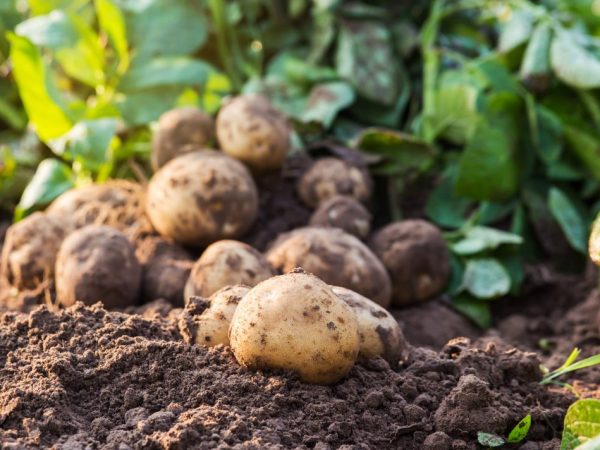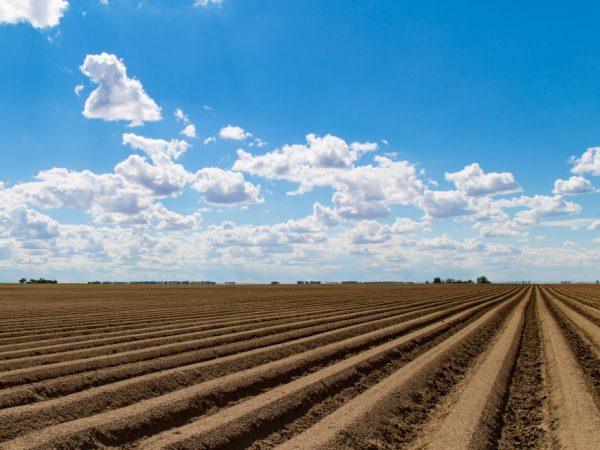Characteristics of Yanka potatoes
The most popular potato varieties are mid-season. Gardeners do not need to rush to planting tubers to obtain products, as with early varieties. And harvesting late-ripening potatoes can coincide with the rainy season. Mid-season varieties such as Yanka potatoes are planted in the sun-warmed ground, care activities are carried out on summer days, and harvested when it is still warm and dry. Therefore, the bushes grow into strong plants, and the tubers, for development, have enough light and moisture, the harvest is collected clean, without autumn dirt.

Characteristics of Yanka potatoes
Characteristics of Janka potatoes
Yanka variety for table use. In addition to the average yield, it has other features.
- From planting tubers to harvesting, no more than 100 days pass.
- Marketable tubers of almost the same mass, about 100g.
- Harvested up to 250c / ha.
- Suitable for all types of culinary processing.
Excellent taste, the presence of 17% starch and 0.4% sugar in cream-colored potatoes, allows you to use tubers for cooking various dishes such as casseroles and potato zrazy, pancakes and dumplings, and much more.
Positive traits
The main advantage of potatoes is their excellent taste. But the characteristics of the pluses include many points.
- The ability to grow in various soils.
- Immunity to major viruses.
- Pest resistance.
- Reacts well to fertilization.
- The variety is resistant to mechanical stress and damage.
- The tubers are stored until the next harvest.
- They are distinguished by good transportability.
Growing the Yanka variety, on any soil, throughout the country, you can see that the yield fluctuates, depending on weather conditions.
Potatoes, even in the rainy season, are not damaged by mosaic viruses, leaf curling. Also, it does not respond to potato cancer, common scab of tubers and the S virus, which, when mixed with other viruses, can reduce the yield by 2 times.

Plant productivity will increase with regular fertilization
The golden potato cyst nematode does not parasitize the roots of this plant. Wireworm, garden moth and bear also do not feed on tubers, leaves, or rhizomes of potatoes. But still, you should not take risks, but it is better to observe crop rotation and treat the soil with insecticides before planting potatoes.
Fertilizing plantings in due time, gardeners achieve higher yields because more tubers are formed in the bushes, and their weight also increases.
If, when harvesting potatoes, the tubers are accidentally damaged, then after drying the sections they are well stored. Potatoes are not injured even during mechanical harvesting. This allows the Janka variety to be grown in large areas and harvested using potato harvesters.
Disadvantages of potatoes
Along with the advantages, the variety also has some negative qualities.
- The bush forms few tubers.
- Both the plant and tubers can be affected by late blight.
- Poorly tolerates the Colorado potato beetle and its larvae.
The decrease in yield depends on the number of tubers that form in dry and unfertilized soil. But with proper watering and sufficient feeding, you can achieve a stable yield, which characterizes these potatoes.
Rains can provoke late blight of stems and leaves. When this happens, it is dealt with with chemicals.
Description of the plant
Jan's bushes grow up to 60cm. Stems are erect, but tend to be partially tilted. The shape of the stem is ribbed, and the color is green with yellowness. A lot of leaves, medium-sized, potato type are formed on the bush. The color of the leaves is light green, matte. The lower part of the bush is often exposed when there is not enough light.
The tops of each stem bear clusters of simple flowers. Their corollas are half-grown, delicate white. Pollination occurs naturally. Berries that have set may fall off completely. This property of the plant causes great damage during seed propagation of potatoes at selection stations.
Each bush forms up to 12 tubers. At the stage of technical maturity, they are oval, deep yellow in color. The peel of potatoes is weakly reticulate. On the surface, small depressions are almost invisible, in which, over time, eyes grow. They are small, white with pink extension buds.
Preparing the area for planting
On fertile lands, only humus is introduced into the soil, 35 buckets per hundred square meters. Clay soil can be improved by adding screenings, wood ash and mullein, which has been in the compost pit for a couple of years. But it is better to form earthen ridges with these additives, on which to fill holes or dig holes.

The soil needs to be prepared for planting
The recommendations of experts say that the distance between the ridges should not be less than 60 cm and it is desirable to place them, orienting from north to south. With this arrangement, the rows will be well lit all day, which will allow the plant to produce chlorophyll and feed the tubers.
About 25 cm is left between the planting pits. Their maximum depth is 10-12 cm, for medium-sized seed potatoes.
A handful of ash and onion husks are added to each pit, which repels pests. You also need to add a mixture of mineral fertilizers, 1 tsp each. per well, and if for 1m², then 35 g:
- ammonium nitrate;
- nitroammophos;
- azofoski;
- potassium salt.
A large amount of nitrogen fertilizers can provoke the growth of the bush. It will be luxurious with large stems and leaves. But, fruit tubers, when harvested, will be weak and small.
Preparing tubers for planting
A month before planting, you need to inspect the planting material for damage and rot. Only healthy potatoes that have not lost their turgor during storage are allowed for reproduction. They are laid out in boxes in 1 or 2 layers and exposed to light for landscaping and germination at a temperature of 15 ° C.
When the sprouts reach 3 cm in height, they are treated with Prestige and planted in prepared planting pits. Carefully sprinkle with soil so as not to damage fragile shoots. Then the surface is leveled with a rake.
Growing Yanka potatoes
After the emergence of seedlings, measures are taken to take care of the plants.
- Necessarily need weeding from weeds, hilling and loosening of the soil.
- In arid regions, it is necessary to water the areas with potatoes at least 3 times.
- Even fertile soils are fertilized 2 times during the growing season.
- As pests appear, fight them.
You can huddle the bushes if there are seedlings. They huddle for the second time to a height of up to 10 cm, when buds are formed. The third time you can carry out this procedure when ripening berries on the bushes. Weeding and loosening of the soil is carried out as needed. Weeds are left between the rows, they serve as green top dressing and as mulch.Loosening is necessary for better air penetration into the lower layers of the soil.
Almost always, watering the plantings is combined with feeding them. For this, complex mineral fertilizers or rotted mullein and chicken droppings are used. They are bred 1:15 and kept warm for about 2 days. The finished mixture can be further diluted 1: 0.5 with water so as not to burn the plants and then watered at the root.
The description says that for the prevention of viruses and diseases, even if the variety is resistant to them, ash is used, with which the plantings are pollinated. Viruses are most often carried by aphids, so you need to spray the bushes with broad-spectrum insecticides that will destroy the Colorado potato beetle with its larvae. Antizhuk, Aktara, Colorado Forte and other drugs are purchased to fight insects. It is necessary to spray in calm weather, strictly observing the recipe for preparation and not forgetting about personal protective equipment. Observing the correct agricultural technique, you can grow up to 400c / ha. When storing products, do not worry that the tubers will lose their presentation, become flabby and tasteless.
Conclusion
Growing a large, environmentally friendly harvest is not at all difficult. You need to follow the recommendations for growing potatoes and make every effort to get tasty and healthy vegetables. This will help a description of the characteristics of the Yanka variety and the peculiarities of caring for potatoes, without which no housewife can do.


